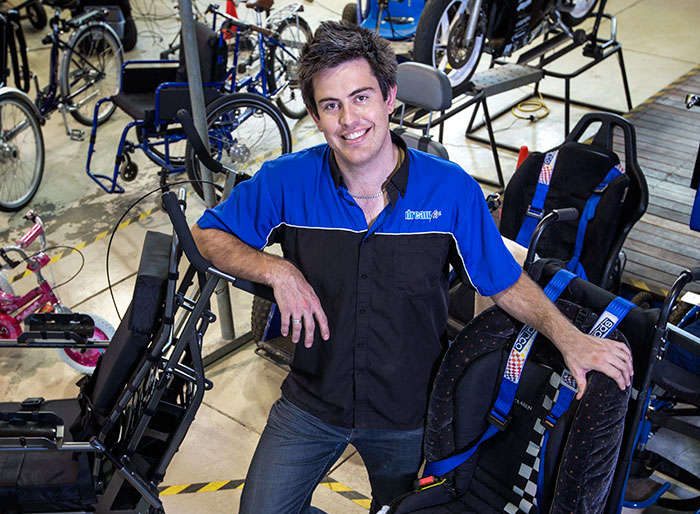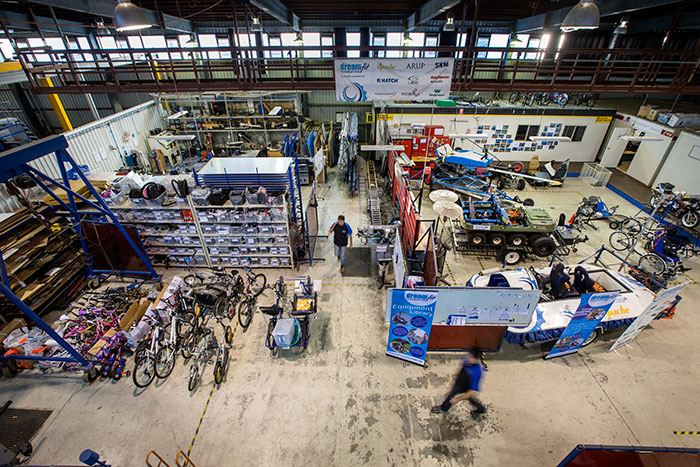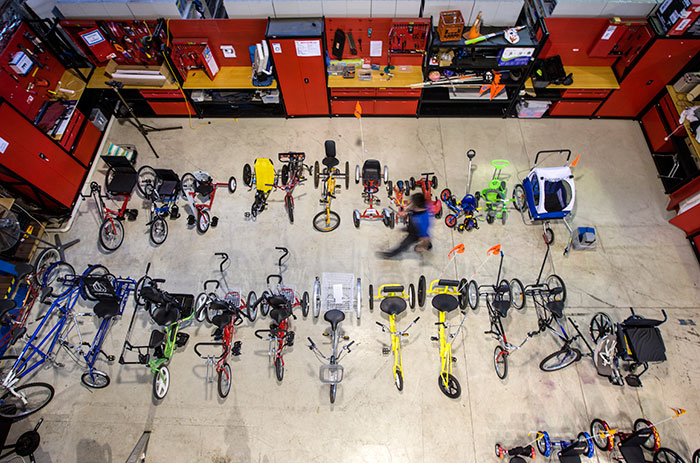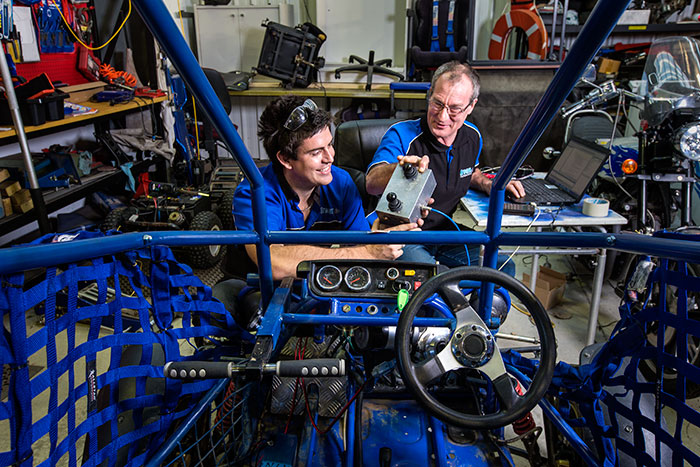A serendipitous encounter with a motocross-loving quadriplegic set the wheels in motion for Darren Lomann to create a customised motorbike.
Eamon Guilfoile wants to ride a bike. He wants to feel the air whoosh past, see the light filtering through the trees, know the joy of moving. Seems simple, right? But for the 18-year-old – who was born with spastic quadriplegia-type cerebral palsy, and who is intellectually disabled and visually impaired – the modest dream of riding a bike is anything but. After all, where on earth would someone with disabilities so rare and severe find a bike to ride?
The answer lies with WA engineer Darren Lomann, who since 2003 has been stretching the limits of his imagination to create custom equipment for people with disabilities. His non-profit Dreamfit Foundation has created everything from bicycles for limbless kids to electronic art easels for people with quadriplegia.
It all started when Darren was a young engineering student at UWA who couldn't decide what to do for a third-year engineering project. Everything seemed so academic. So dry. So... useless. Darren wanted to make a difference.
"I thought, in a couple of years I'm going to be graduating and most likely working as an engineer in the mining-resource sector, as a diligent employee – so one of my last projects would be a chance to do something useful and help someone out," he says. "I had no idea what – I just wanted to do good in the world."

Darren Lomann. Photography by Ross Swanborough.
In between semester breaks, a chance encounter gave him his answer. "I happened to ride my motorbike into a hospital car park and a man in a wheelchair wheeled himself over and started lecturing me," says Darren. "'Be careful with that motorbike. They're dangerous. I'm in a wheelchair because of a motorbike accident'."
Darren stayed and chatted, and as they talked, the man revealed his enduring – if bittersweet – love of motorbikes. "He told me he was a motocross champion, that he had ridden since he was three, and owned a motorbike shop – his whole life had been about motorbikes," said Darren. "He said if he had one wish, it would be to ride again." Thus the wheels of possibility began turning in Darren's mind.
"I'd been looking for a project, and what a cool project that was!" says Darren. "I said, 'I'm going to build you a bike so you can ride again.' I had an idea by the end of that evening."

Though UWA staff met his idea with some apprehension ("They almost fell over backwards, I think it was a bit bigger than a typical third-year project"), they gave
him the green light, but with a catch: a $50 budget. Anything more than that he would have to fund himself.
"I started contacting motorbike companies, but they weren't keen to support people who had spine-breaking motorbike injuries – not the greatest PR for them," he says. "All the disability organisations said, 'No, we're broke, we're struggling to get funds for what we want to do'. And the places that sold parts said they had none for us."
But persistence paid off. Darren contacted nearly 200 companies, before reaching one that agreed to come on board. A chain reaction ensued. By the end, 40 companies had come out in support of his project.

Word-of-mouth prompted further requests for special equipment. Today, the full-time enterprise has a staff of five on a 1500sqm site in Shenton Park, courtesy of an annual $1 peppercorn lease through his alma mater. "We've gone from doing a couple of projects, to this year doing a couple of hundred," he says.
The foundation injected a $300,000 State Government grant into a trading arm to manufacture multiple units of customised products. "In the past, everything was a custom one-off solution," says Darren. Each enquiry had prompted a return to the drawing board, but the digital age now means he has design files for most solutions and can manufacture and sell items around the country more quickly.
Next, Darren plans an online product catalogue to give more people with disabilities a better sense of what's possible. And what's possible can be a revelation. His current projects are imaginative and far-reaching, stretching the limits of what it means to be disabled.
"Every day is different," says Darren. "Right now, we're working on a fishing casting system for people with disabilities, so with the press of a button they can cast their own fishing line out to the water; with the press of another button they can reel their fish back in." A tennis-ball launcher for a wheelchair-bound dog lover, and a ten-pin bowling system for people with very high-level disability are also underway.

Gypsy Wulff, a 59-year-old piano teacher, was diagnosed with muscular dystrophy at 24. Five years ago, she lost mobility in her arms and legs and now uses a wheelchair. "It's just awkward more than anything," she says. "Your mobility is impacted significantly." An avid fan of yoga, Gypsy found that getting to the floor to practise was increasingly difficult.
She searched online without success for a chair that would lower her to the floor. Then, her cousin mentioned Dreamfit and she approached Darren about making a lift – with a single proviso. "It had to be pink," she says with a laugh. And pink it is. Fellow muscular dystrophy sufferers are so impressed by the design and functionality that they want one too. "I use mine every day," she says. "I don't know what I'd do without it."
Meanwhile, Eamon Guilfoile awaits with excitement the completion of the tandem bike Dreamfit began making him 18 months ago. "Bike riding is more of a recreational activity that other people do, people without disabilities, so it helps Eamon belong to the community," says his mother, Julie. "A lot of people find
a wheelchair alienating or are unsure of the person's abilities. On a tandem, people are more likely to wave when you go past; if you stop for a drink of water, they'll talk with you. It's a more natural way of engaging people."